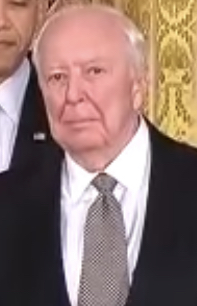
Jasper Johns is an American painter, sculptor, and printmaker whose work is associated with abstract expressionism, Neo-Dada, and pop art. He is well known for his depictions of the American flag and other US-related topics. Johns's works regularly sell for millions of dollars at sale and auction, including a reported $110 million sale in 2010. At multiple times works by Johns have held the title of most paid for a work by a living artist.
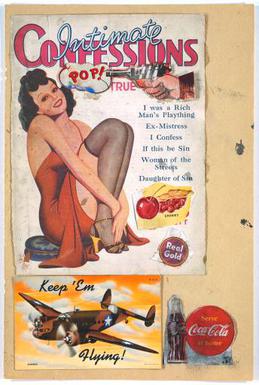
Pop art is an art movement that emerged in the United Kingdom and the United States during the mid- to late-1950s. The movement presented a challenge to traditions of fine art by including imagery from popular and mass culture, such as advertising, comic books and mundane mass-produced objects. One of its aims is to use images of popular culture in art, emphasizing the banal or kitschy elements of any culture, most often through the use of irony. It is also associated with the artists' use of mechanical means of reproduction or rendering techniques. In pop art, material is sometimes visually removed from its known context, isolated, or combined with unrelated material.

Frank Philip Stella is an American painter, sculptor and printmaker, noted for his work in the areas of minimalism and post-painterly abstraction. Stella lives and works in New York City.

Milton Ernest "Robert" Rauschenberg was an American painter and graphic artist whose early works anticipated the Pop art movement. Rauschenberg is well known for his Combines (1954–1964), a group of artworks which incorporated everyday objects as art materials and which blurred the distinctions between painting and sculpture. Rauschenberg was both a painter and a sculptor, but he also worked with photography, printmaking, papermaking and performance.

Monochromatic painting has been an important component of avant-garde visual art throughout the 20th century and into the 21st century. Painters have created the exploration of one color, examining values changing across a surface, texture, and nuance, expressing a wide variety of emotions, intentions, and meanings in many different forms. From geometric precision to expressionism, the monochrome has proved to be a durable idiom in Contemporary art.

Elaine Frances Sturtevant, also known professionally as Sturtevant, was an American artist. She achieved recognition for her carefully inexact repetitions of other artists' works.

Edwin Parker "Cy" Twombly Jr. was an American painter, sculptor and photographer. He belonged to the generation of Robert Rauschenberg and Jasper Johns.

John Kirk Train Varnedoe was an American art historian, the Chief Curator of Painting and Sculpture at the Museum of Modern Art from 1988 to 2001, Professor of the History of Art at the Institute for Advanced Study in Princeton, New Jersey, and Professor of Fine Arts at the New York University Institute of Fine Arts.
In the visual arts, late modernism encompasses the overall production of most recent art made between the aftermath of World War II and the early years of the 21st century. The terminology often points to similarities between late modernism and post-modernism although there are differences. The predominant term for art produced since the 1950s is contemporary art. Not all art labelled as contemporary art is modernist or post-modern, and the broader term encompasses both artists who continue to work in modern and late modernist traditions, as well as artists who reject modernism for post-modernism or other reasons. Arthur Danto argues explicitly in After the End of Art that contemporaneity was the broader term, and that postmodern objects represent a subsector of the contemporary movement which replaced modernity and modernism, while other notable critics: Hilton Kramer, Robert C. Morgan, Kirk Varnedoe, Jean-François Lyotard and others have argued that postmodern objects are at best relative to modernist works.

The Bottle Rack is a proto-Dada artwork created in 1914 by Marcel Duchamp. Duchamp labeled the piece a "readymade", a term he used to describe his collection of ordinary, manufactured objects not commonly associated with art. The readymades did not have the serious tone of European Dada works, which criticized the violence of World War I, and instead focused on a more nonsensical nature, chosen purely on the basis of a "visual indifference".
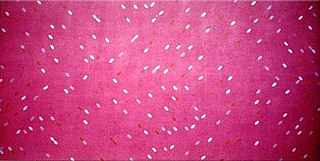
Lawrence M. "Larry" Poons is an American abstract painter. Poons was born in Tokyo, Japan, and studied from 1955 to 1957 at the New England Conservatory of Music, with the intent of becoming a professional musician. After seeing Barnett Newman's exhibition at French and Company in 1959, he gave up musical composition and enrolled at the School of the Museum of Fine Arts, Boston. He also studied at the Art Students League of New York. Poons taught at The Art Students League from 1966 to 1970 and currently teaches at the League.
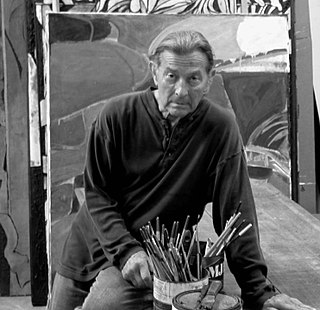
James Jarvaise was an American painter based in Southern California.
The Foundation for Contemporary Arts (FCA), is a nonprofit based foundation in New York City that offers financial support and recognition to contemporary performing and visual artists through awards for artistic innovation and potential. It was established in 1963 as the Foundation for Contemporary Performance Arts by artists Jasper Johns, John Cage, and others.
Agnes Gund is an American philanthropist and arts patron, collector of modern and contemporary art, and arts education and social justice advocate. She is President Emerita and Life Trustee of the Museum of Modern Art (MoMA) and Chairman of its International Council. She is a board member of MoMA PS1. In 1977, in response to New York City's fiscal crisis that led to budget cuts that virtually eliminated arts education in public schools, Gund founded Studio in a School, a nonprofit organization that engages professional artists as art instructors in public schools and community-based organizations to lead classes in drawing, printmaking, painting, collage, sculpture, and digital media, and to work with classroom teachers, administrators, and families to incorporate visual art into their school communities.

Minimalism describes movements in various forms of art and design, especially visual art and music, where the work is set out to expose the essence, essentials or identity of a subject through eliminating all non-essential forms, features or concepts. As a specific movement in the arts it is identified with developments in post–World War II Western Art, most strongly with American visual arts in the 1960s and early 1970s. Prominent artists associated with this movement include Ad Reinhardt, Nassos Daphnis, Tony Smith, Donald Judd, John McCracken, Agnes Martin, Dan Flavin, Robert Morris, Larry Bell, Anne Truitt, Yves Klein and Frank Stella. Artists themselves have sometimes reacted against the label due to the negative implication of the work being simplistic. Minimalism is often interpreted as a reaction to abstract expressionism and a bridge to postminimal art practices.

Monogram is a Combine by American artist Robert Rauschenberg, made from 1955-1959. It consists of a stuffed Angora goat with its midsection passing through an automobile tire. Critic Jorg von Uthmann described it as Rauschenberg's most famous work in the Huffington Post. In 1965, Pontus Hultén purchased the artwork for the collection of the Moderna Museet in Stockholm.

Erased de Kooning Drawing (1953) is an early work of American artist Robert Rauschenberg. This conceptual work presents an almost blank piece of paper in a gilded frame. It was created in 1953 when Rauschenberg erased a drawing he obtained from the Abstract Expressionist and American artist Willem de Kooning. Rauschenberg's friend and fellow artist, Jasper Johns, later framed it in a gilded frame and added a written caption to mimic the framing style of the Royal Academy and monogramming found on Renaissance drawings and prints. The caption reads: "Erased de Kooning Drawing, Robert Rauschenberg, 1953.” It has been in the collection of the San Francisco Museum of Modern Art (SFMOMA) since 1998. SFMOMA describes the work as a "drawing [with] traces of drawing media on paper with a label and gilded frame."

Reservoir is a 1961 painting by American artist Robert Rauschenberg. The work is one of his Combines, which incorporate both two- and three-dimensional found, non-art materials, using objects Rauschenberg collected from the streets of his lower Manhattan neighborhood. Reservoir is in the collection of the Smithsonian American Art Museum, in Washington, D.C. According to the museum, the artwork incorporates a length of wood, two clocks, and two cast-off wheels which evoke the always changing and surprising contrasts of everyday experience. The seemingly spontaneous arrangement of objects and the quick, gestural brushstrokes evoke the legacy of Abstract Expression. The two clocks record the time he started making the artwork and the moment he considered it finished.
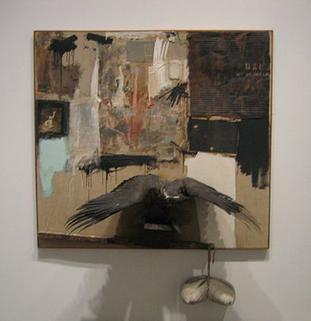
Canyon is a 1959 artwork by American artist Robert Rauschenberg. The piece is one of his most celebrated and best known works, and is one of his Combines. Rauschenberg coined the phrase Combine in 1954 to describe his artworks that incorporate elements of both sculpture and painting. Canyon includes a taxidermied golden eagle and a pillow, along with other sculptural elements mounted on a painted and collaged canvas.

Robert Yasuda is an American abstract painter, most known for contemplative, atmospheric works that straddle painting, sculpture and architecture. He first attracted wide attention in the 1970s for large wall works merging painting and installation art, mounted at MoMA PS1, the Corcoran Museum of Art, and Museum of Contemporary Art, Chicago. Since the 1990s, he has focused on paintings that disrupt conventional formats using hand-carved wood panels and custom framing elements, upon which he builds multi-layered iridescent surfaces that respond dynamically to shifting conditions of light, time and vantage. Reviewing this later work, ARTnews critic Barbara MacAdam described Yasuda as a "romantic minimalist" whose paintings present an intangible, fleeting reality that is nonetheless referential, showing his roots in their construction, shifting tones and titles.


















